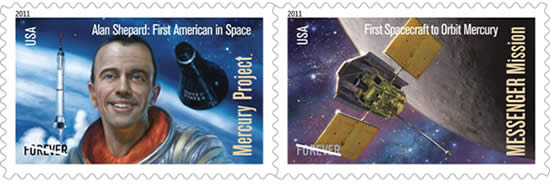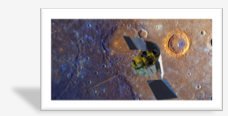 After only six months in orbit around Mercury, NASA’s MESSENGER spacecraft is sending back information revolutionizing the way scientists think about the innermost planet. Analysis of data from the spacecraft shows, among other things, evidence of widespread flood volcanism; the first close-up views of Mercury’s “hollows”; the first direct measurements of the chemical composition of Mercury’s surface; and the first global inventory of plasma ions within Mercury’s space environment.
After only six months in orbit around Mercury, NASA’s MESSENGER spacecraft is sending back information revolutionizing the way scientists think about the innermost planet. Analysis of data from the spacecraft shows, among other things, evidence of widespread flood volcanism; the first close-up views of Mercury’s “hollows”; the first direct measurements of the chemical composition of Mercury’s surface; and the first global inventory of plasma ions within Mercury’s space environment.This update provides current information for the Heat, Temperature and Energy: MESSENGER — Cooling With Sunshades lesson on the NASA Explorer Schools Virtual Campus.
Link to the NES Virtual Campus home page.

 The 50th anniversary of America’s first manned spaceflight is being commemorated with the issuance of two stamps. The stamps went on sale May 4, 2011.
The 50th anniversary of America’s first manned spaceflight is being commemorated with the issuance of two stamps. The stamps went on sale May 4, 2011. NASA will host a news conference at 1 p.m. EDT on Thursday, June 16, to reveal new images and science findings from the first spacecraft to orbit Mercury. The event will be held in the NASA Headquarters. NASA Television and the
NASA will host a news conference at 1 p.m. EDT on Thursday, June 16, to reveal new images and science findings from the first spacecraft to orbit Mercury. The event will be held in the NASA Headquarters. NASA Television and the  This is a cool lesson related to MESSENGER’s mission to Mercury and the Inuit people inhabiting the Arctic region. By studying ancient solutions to the issue of excessive sunlight on human vision, students better understand the process of designing solutions to similar problems for MESSENGER.
This is a cool lesson related to MESSENGER’s mission to Mercury and the Inuit people inhabiting the Arctic region. By studying ancient solutions to the issue of excessive sunlight on human vision, students better understand the process of designing solutions to similar problems for MESSENGER.
 Here is a great idea for the Messenger: Staying Cool — My Angle on Cooling Effects of Distance and Inclination module. Your students can create solar “cookers.” One of the variables is choosing how the sun enters the cooker, either directly or at an angle. Share with us on NEON your students/ results.
Here is a great idea for the Messenger: Staying Cool — My Angle on Cooling Effects of Distance and Inclination module. Your students can create solar “cookers.” One of the variables is choosing how the sun enters the cooker, either directly or at an angle. Share with us on NEON your students/ results.